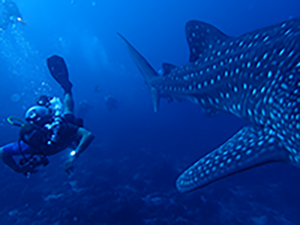 Did it ever happen to you that you approached a fish and it ran away as if the devil was after it? The excitement of being close to the fantastic beings that inhabit the oceans can not be compared to any other sensation in life. We all agree in one thing, it is not the same to see a shark in 20 meters distance as having it around within 2 meters and watching you with curiosity.
Did it ever happen to you that you approached a fish and it ran away as if the devil was after it? The excitement of being close to the fantastic beings that inhabit the oceans can not be compared to any other sensation in life. We all agree in one thing, it is not the same to see a shark in 20 meters distance as having it around within 2 meters and watching you with curiosity.
So, what does it depend on for an aquatic creature to let you get close to it or run away from you? The truth, depends on too many factors, most of them beyond our control. But many times, it also depends on the diver. And that we can control. The way you approach, your attitude, your movements …
Everything you do underwater transmits information to the fish around you. When diving, you become part of a new world with its own interaction rules. It is important to understand those rules. Knowing how fish interact with other fish will help us to enjoy the company of some animals much longer than what you can imagine. Let’s put the case of touching. When we cares another human being we communicate love and care. If you cares a fish you will communicate aggression or the will to eat it. Two very opposite meanings for one same action. Such is the difference between our two worlds.
Everything you do underwater transmits information to the fish around you. Since you are underwater, you are a fish and you have to learn the language they speak. It will never be the other way around.
It is important to understand that divers, we are very big “animals” in comparison to underwater life. Lets say an average man of 1,75m tall, plus 1m fins, this means we are a 2,75m “fish” when underwater. The size already makes us fearsome. However, there are few things you can do to seem less scary for the fish. The most important is to understand that since you are underwater, you are a fish and you have to learn the language they speak. It will never be the other way around.
7 Tips to remain near Fish
1 – Never swim straight towards the animal
 Imagine the following two situations:
Imagine the following two situations:
A lion walks in front of you slowly, with distracted eyes, smelling the environment and as if you were nothing more important than the tree in front of it or the flies that bother it.
A lion runs swiftly straight at you with the gaze fixed on you and the exorbitant eyes.
Which of the two situations do you think you are most at risk?
A fast and straight approach is very aggressive. Underwater it means one of those 2 things: “I want to eat you” or “I want to fight for the spot you are using”. Try to approach slow and maybe in a disguised and not direct way, or making a little round before reaching the animal. It is very important that you swim slowly. You will see your objective in alert, observing you and your movements. It will analyse you to decide either you are dangerous or not. Whenever you swim directly into it, it will not doubt that you bring bad intentions.
2 – Slow movements
This is easy to understand. Fast movements are scary for most of the living beings in this planet, fish are no exception. Never be surprised if a fish scares and runs away after one fast movement of your arm or leg. Try to put your arms close to your body, as if they were part of it. This always works better than having them spread out like tentacles ready to catch a prey. if you find it difficult to maintain the position …Time to improve buoyancy!!
3 – Don’t face the animal
Fish fight face to face. They look at each other, pull out the dorsal fins in anger and, if there is not one that surrenders, the fight begins. Try to show your side if possible. Showing the side, underwater, is synonymous with surrendering. It means “I do not want to fight”. It is obvious that if you transmit the fight signal (facing the fish), most probably the only possible result is that the fish will run away.. If it moves around, don’t follow it with your entire body, do it with your eyes. Imagine you are dancing with it and the only rule is not to face the fish. And don’t forget to enjoy the dance.
Swimming sideways allows the diver to get closer to the school of fish. If the diver would approach perpendicular, he would cause a disbandment of the whole group and an unnecessary stress. The diver would create a distrust in the group of fish, and would be seen as a predator.
4 – Breathe Slowly
Our bubbles scare fish. If you breath hard, you will make a lot of scary noisy bubbles. Try to breath out really slowly and try to be constant in your breath. Remember that underwater bubbles are uncommon. The only animals that produce bubbles are marine mammals. For us, whales, dolphins and seals are wonderful animals that we love. For fish, they are fearsome predators. It is in his instinct to flee and hide from any animal that makes bubbles. This lesson is learned very clearly when one dives with CCR. Suddenly the fish seem to be approaching you more than usual. Why? Because there are no bubbles. So, if you’re not ready to try diving with CCR, at least remember that constant little bubbles will be less scary for the fish than if all of the sudden you blow out a massive amount of bubbles.
5 – Avoid eye contact
 Eye contact is very aggressive underwater. You must understand that looking directly and steadily towards a fish is to show a high interest in it. What are the reasons why a fish would stare at another? There are many reasons, but none of them are friendly. If you realise that you are scaring the poor animal, try to look somewhere around and avoid the eye contact for few seconds.
Eye contact is very aggressive underwater. You must understand that looking directly and steadily towards a fish is to show a high interest in it. What are the reasons why a fish would stare at another? There are many reasons, but none of them are friendly. If you realise that you are scaring the poor animal, try to look somewhere around and avoid the eye contact for few seconds.
6 – Avoid corralling them – lower your level
You must leave some escape options for the fish. Corralling is a technique some animals use to haunt. Many times, the only reason a fish would attack a diver is because it feels corralled. Without escape. If you leave a free path to escape, it will feel much more relaxed than if its only way out is towards you. In case of stingrays and other animals resting in the sand, swimming above them makes them very nervous. For clearly the only danger that can come is from above. Stay to one side, lower your level near the sand and approach to it very slowly.
7 – Swim away
 It is very hard to remain close to a fish when it is already scared, but you still have a chance. Try to pretend you are scared too and that you swim away. Put your fins between you and the fish. This attitude, underwater, means submission. Kick a bit backwards as if you would be scared of it and running away. You might have one chance to communicate to the fish that you feel threatened, which might stop it to flee from you. Remember, everything with slow movements.
It is very hard to remain close to a fish when it is already scared, but you still have a chance. Try to pretend you are scared too and that you swim away. Put your fins between you and the fish. This attitude, underwater, means submission. Kick a bit backwards as if you would be scared of it and running away. You might have one chance to communicate to the fish that you feel threatened, which might stop it to flee from you. Remember, everything with slow movements.
Approaching a fish and remaining close to it for a while is not always easy. It is neither an exact science. If you are willing to spend some time and practice, you will start understanding and interacting with them and you will discover that each fish has its own behaviour and rules. You will learn which tips work better with every animal you interact with. And the best, you will start enjoying an unknown part of diving for you. You will have unaccountable moments such the feeling that you are dancing with the fish, or even better…You made a new friend!
